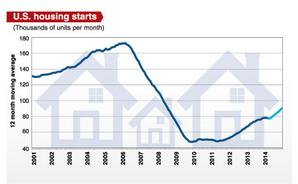Bill Wood
Published: May 5, 2014 12:32 pm ET
Updated: May 5, 2014 12:38 pm ET

Image By: Plastics News
After a shaky start in the first quarter of this year, the residential construction sector is now poised to regain upward momentum and get back on a track of steady growth.
The severe weather this past winter curtailed residential construction activity throughout most of the country, but we still expect that in 2014 the total number of new houses started will exceed 1 million units for the first time since 2007.
Not only is this good news for processors who manufacture plastic building materials, but expanding construction activity will benefit all types of manufacturing and the United States economy as well.
There are a couple of reasons for this. First, the residential construction sector is a major source of jobs in America. We all know by now that job growth has been sluggish in the U.S., and this trend must accelerate if the economy is ever going to get back to full recovery. Trends in the employment and construction data are dependent on each other.
Second, it was the bursting of the housing bubble that plunged the U.S. economy into the Great Recession six years ago. This caused a lot of structural damage to the economy from which we have not yet fully recovered.
A healthy construction sector is a prerequisite to a healthy economy in the long run. Once America is reliably and predictably building things once again, the confidence levels for both consumers and businesses will rise and the economy will be on much better footing.
We are all well aware that the construction sector has languished through a subpar performance thus far in the recovery, but there is increasing evidence to suggest that things are finally getting better. If this is accurate, then it will push demand for many types of plastics products higher.
This is true not only for suppliers of plastics building materials and parts for household appliances, but the automotive, lawn and garden, sporting-goods and packaging sectors also do better when the residential construction data are steadily improving.
There are a couple of indicators of activity levels in residential construction about which plastics processors should stay regularly apprised. Here we offer a quick overview of these indicators that are compiled and reported by the U.S. Census Bureau and our outlook for the coming year.
Housing starts
After a robust increase of 18 percent in the number of new houses started in 2013, there was a modest decline in housing starts in the first quarter of 2014 when compared with a year ago. Our research indicates that demand for many types of vinyl building products (siding, pipe, profiles and decking) is also down a bit in the first quarter when compared with last year.

Image By: Plastics News graphic by Jessica Jordan
We are blaming most of this on bad weather, but there were some other issues in some regions such as: a shortage of building lots; shortages of skilled labor; and difficulty getting some banks to lend money for mortgages to anyone without a pristine credit history and a big down payment.
The good news is that these issues are steadily being resolved, and we fully expect growth in the new residential construction data to resume in the second quarter of this year and beyond.
The data on the number of building permits issued for new houses, which is reported along with the data on new housing starts, is up a solid 7 percent in the first quarter from year-ago levels. Our latest forecast calls for an annual total of just over 1 million units in 2014 which represents an increase over last year of about 8 percent. And even at this level of housing starts there will still be pent-up demand.
In order to accommodate all of the new household formations and also replace the aging housing stock that is becoming obsolete or damaged beyond repair, we need to average a rate of more than 1.2 million new units started every year. So there is still upside for processors who manufacture building products and other goods for this market.
Residential construction spending
While the number of new units started slipped a bit in first quarter, the amount of money spent on residential construction products spiked upward by more than 10 percent in the first three months of 2014. The difference is due to the fact that the spending data includes not only spending on new houses, but also spending on renovations, alterations and repairs to existing houses.
There are several factors at work here, some of them long-term and some of them more short-term in nature. On the long-term side, the memories of the burst in the housing bubble seven years ago changed the spending patterns for many Americans with regards to housing. Americans who had purchased new homes during the bubble found themselves underwater and under stress once it burst. Those Americans who had not purchased new homes during the bubble years were rewarded for standing pat. So now all Americans are thinking twice about buying a new home and many are choosing to upgrade the homes they already have. This is driving spending on additions and alterations.
This shift in long-term spending behaviors notwithstanding, there are some pressing short-term reasons that are also pushing residential construction spending upward. The severe winter weather combined with a rash of other natural disasters in recent months (floods, mudslides, tornadoes, brushfires, etc.) created the need for a lot of home repair.
Energy prices are also quite high, and the cold winter prompted many homeowners to invest in products that enhance the energy efficiency of their homes. All of this bodes well for suppliers of replacement windows and doors, pipe, siding, roofing materials, decking and barrier films.
Interest rates remain quite low, the employment and income data are rising, and credit conditions are starting to ease. With the exception of the past few years, the residential construction sector has been an engine for economic growth out of recession in every business cycle since World War II.
It has taken five long years, but it looks like this may finally be the year that the construction sector finds its groove, and the economic recovery starts to behave the way it should. But either way, the data on housing starts, permits and construction spending in the next quarter or two will tell the tale. Stay tuned. | 